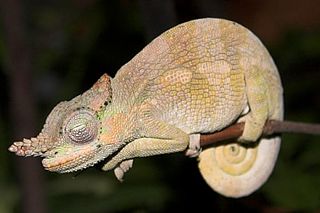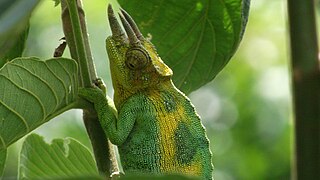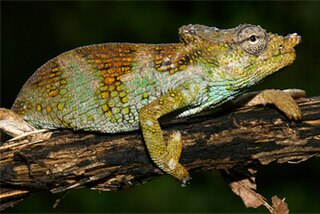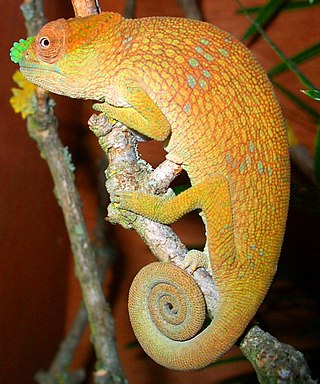
Fischer's chameleon, also known commonly as the Nguru blade-horned chameleon and the Nguru two-horned chameleon, is a species of chameleon, a lizard in the family Chamaeleonidae. The species is endemic to Tanzania.

Duke Adolf Friedrich Albrecht Heinrich of Mecklenburg-Schwerin, was a German explorer in Africa, a colonial politician, the elected duke of the United Baltic Duchy from 5 November to 28 November 1918, and the first president of the National Olympic Committee of West Germany (1949–1951).

Kinyongia is a chameleon genus recently established for several plesiomorphic species found in forest and woodland in Kenya, Tanzania, Uganda, Rwanda, and far eastern DR Congo. All except K. adolfifriderici and K. tavetana are restricted to highlands, and many have very small geographic ranges. In most, at least the males have horns or knobs on their noses. They had been placed into the genus Bradypodion for some time. It has recently been pointed out that the ending to the specific epithet in several of the below listed species should be modified to match the feminine genus name.

Trioceros johnstoni, known commonly as Johnston's chameleon, Johnston's three-horned chameleon, or the Ruwenzori three-horned chameleon, is an endemic chameleon of the Albertine Rift in Central Africa.

Kinyongia vanheygeni, the Poroto single-horned chameleon or Van Heygen's chameleon, is a species of chameleon, a lizard in the family Chamaeleonidae.

The West Usambara two-horned chameleon or West Usambara blade-horned chameleon is a chameleon endemic to the West Usambara Mountains of Tanzania. Until 2008, it was generally confused with Fischer's chameleon, which is not found in the Usambara Mountains. Another related species, K. vosseleri, occurs in the same range as K. multituberculata, while K. matschiei is restricted to the East Usambaras.

Kinyongia tavetana is a chameleon in the genus Kinyongia. It is native to southern Kenya and northern Tanzania. Its type locality is Mount Kilimanjaro, but it is also known from Chyulu Hills and Mount Meru to the Pare Mountains. Until 2008, it was widely confused with K. fischeri, but the ranges of the two species do not overlap.
Letheobia graueri, also known as the Lake Tanganyika gracile blind snake, Grauer's gracile blind snake, Sternfeld's beaked snake, Grauer's blind snake, is a species of snake in the family Typhlopidae. The species is endemic to Middle and East Africa.
Kinyongia carpenteri, commonly called Carpenter's chameleon or the helmeted chameleon, is a species of chameleon, a lizard in the family Chamaeleonidae. The species is native to central Africa.

Kinyongia tenuis, also known as the Usambara soft-horned chameleon, Usambara flap-nosed chameleon, and Matschie's dwarf chameleon is a species of chameleon.

Kinyongia matschiei, common name giant monkey-tailed east Usambara two-horned chameleon, giant east Usambara blade-horned chameleon, and Matschie's two-horned chameleon, is a species of chameleon from the East Usambara Mountains in Tanzania. It was formerly confused with K. fischeri, which is not found in the range of K. matschiei.
Kinyongia asheorum, also known commonly as the Mount Nyiro bearded chameleon, is a species of lizard in the family Chamaeleonidae. The species is endemic to Kenya. Only four specimens are known.

Kinyongia boehmei is species of chameleon, a lizard in the family Chamaeleonidae. The IUCN Red List gives two alternative English common names for this species: Taita blade-horned chameleon and Böhme's two-horned chameleon. The species is endemic to Kenya.

Mount Kenya sentinel chameleon or Mt Kenya hornless chameleon is a species of chameleons endemic to Kenya. It is known from Mount Kenya, Nyambeni Hills, and Aberdare Range.
Kinyongia gyrolepis is a species of kinyongia chameleons first described in 2012, and the sister species to the Kinyongia adolfifridericichameleon. It is more commonly known as the circular-scaled chameleon.

Kinyongia uluguruensis is a species of chameleon, also known as the Uluguru two-horned chameleon or Uluguru two-horned chamaeleon. It is endemic to Tanzania.

Kinyongia uthmoelleri, known commonly as the Hanang hornless chameleon, Müller's leaf chameleon, and Uthmöller's chameleon, is species of lizard in the family Chamaeleonidae. The species is endemic to Tanzania.

Kinyongia vosseleri, also known commonly as the Usambara two-horned chameleon and Vosseler's blade-horned chameleon, is an endangered species of lizard in the family Chamaeleonidae. The species is endemic to Tanzania.
Scheffler's dwarf gecko is a species of lizard in the family Gekkonidae. The species is native to East Africa. There are three recognized subspecies.
Rhampholeon beraduccii, also known commonly as Beraducci's pygmy chameleon or the Mahenge pygmy chameleon, is a species of lizard in the family Chamaeleonidae. The species is endemic to Tanzania.













